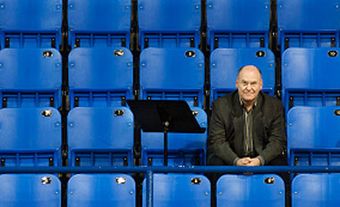In Canada, as in Europe, the piano had eclipsed the harpsichord by the beginning of the 19th century. If there were any early keyboard compositions written by Canadians with the harpsichord in mind, they have not survived.
In the 20th century, the harpsichord regained some of its former popularity, and Canadian musicians slowly rediscovered it. By the 1950s its use was accepted in Canada, especially in the larger centres, as preferable to the piano for the performance of music originally written for the instrument - though eloquent piano performances of Bach's harpsichord music by Glenn Gould and by Rosalyn Tureck kept many from closing their minds on the subject. However, as every important musical organization or university music department moved to procure a harpsichord (if it had not one already), original Canadian compositions for the instrument began to appear. Of 'pioneer' works of the 1950s, Gilles Tremblay's Trois-huit (1950) and Clermont Pépin's Trois Pièces pour 'La Légende dorée' (1956) were designated 'harpsichord or piano,' though R. Murray Schafer's Concerto for Harpsichord and 8 Wind Instruments (1954) and Kelsey Jones' Sonata da Camera (1957, for flute, oboe, and harpsichord) were unequivocal. Jones, the harpsichord in the Baroque Trio of Montreal, later wrote a Prelude, Fughetta, and Finale (1963) for strings and harpsichord and a Sonata da Chiesa (1967) for his trio. Among other notable pieces of the 1960s and 1970s are Barbara Pentland's Canzona (1961, for flute, oboe and harpsichord) and Ostinato and Dance for Harpsichord (1962); Gabriel Charpentier's Suite (from his incidental music for Molière's Le Bourgeois Gentilhomme, 1964), Trois Ricercars (1966, for oboe and harpsichord), and Grande Chaconne (1971, from his music for Brecht's Galileo Galilei); John Beckwith's Circle, with Tangents (1967, for harpsichord and 13 strings); John Fodi's Sonata and Toccata (both 1968) and Divisions II (1972, for piano and harpsichord); Jean Papineau-Couture's Nocturnes (1969, for flute, clarinet, violin, cello, harpsichord, guitar, and percussion) and Dyarchie (1971); Bernard Naylor's On Mrs. Arabella Hunt Singing (1970, for soprano, viola da gamba, and harpsichord); and Rudolf Komorous' At Your Memory the Transparent Tears Fall Like Molten Lead (1976, for viola da gamba and harpsichord).
Works written in and after 1980 for solo harpsichord include Bengt Hambraeus' Capriccio I, Rodney Sharman's Kore (both 1980); Denis Gougeon's Rondeaujourd'hui, Ka Nin Chan's Phantasmagoria, Hope Lee's Melboac, (all 1985); Jan Jarvlepp's Harpsichord Piece, David Eagle's Toccare Alice Ho's Arc (all 1986); Jean Lesage's La Tentation d'Arlequin (1984) and Tanatopsis (1986); André Villeneuve's Vers la 'Quatrième Terre' (1986-7); Wendy Prezament's Two Pieces for Harpsichord (1987), Pierre Desrochers' Cinema-mode d'emploi, Linda C. Smith's Gravity, Brian Cherney's Déploration (all 1988); Cherney's Hommage à Morton Feldman (1989); François Rose's A perte d'espace and Bruce Mather's Saumur (both 1990).
Other works for harpsichord include Tim Brady's Doubling (1988) with electric guitar; Prezament's Acchord and Lee's In the Beginning was the End (both 1989) with accordion; Desrochers' Cinema Vérité (1987) for six harpsichords, Lesage's Les Unités discretes (1987), Serge Provost's Crètes (1980), and Denis Lorrain's La Nuova Ricordanza (1986), all for two harpsichords; Bruce Pennycook's The Desert Speaks (1988), David Keane's Turbo Toccata (1989), and Stéphane Volet's Retors (1990), all for MIDI harpsichord; and Micheline Coulombe Saint-Marcoux's Miroirs (1975-6), Brady's Reaching Past (1988), and Paul Dolden's Physics of Seduction (1991), all for harpsichord and tape. Beckwith's Keyboard Practice (1979), A Concert of Myths (1983), and Avowals (1985) also contain significant harpsichord parts.
No attempt has been made in these works to compose on archaistic lines. Rather, the composers have attempted to exploit the textures and sonorities of harpsichord sound in the various 20th-century idioms in which they work. Of all those composers mentioned, Charpentier probably has been the most persistent user of the harpsichord. Besides the works mentioned, his Quand nous serons heureux (1968-76), Trois Oraisons (1971), and Processional (1974) and much of his incidental music, contain important harpsichord parts.
The Canada Council has been very supportive of new compositions for the harpsichord. The OAC and MACQ have also awarded commissions. Most of the works written for the harpsichord in Canada from the mid-1970s on are for the historical-copy instruments (Dowd, Hubbard), not the large, modern harpsichord (like the Pleyel or Neupert) whose heavy action resembles that of the piano (foot-pedals for stop changes, 16-foot wound strings, metal frames). The indication 'for piano or harpsichord' on many scores of the 1950's, 1960's, and early 1970's was an indication of the proliferation of the latter instrument. Its popularity declined in the mid-1970s, and many works written for it are not performable on the historical-copy instruments. Many schools, universities, colleges, and orchestras possess historical-copy harpsichords.
Vivienne Spiteri specializes in and concentrates fully on the commissioning and performance of new harpsichord music. The surge of Canadian repertoire for the harpsichord beginning ca 1986 is mostly due to Spiteri, who gave her first full recital devoted to new music at the Music Gallery in Toronto in May 1986. The Canadian Music Centre's annual catelogue of works received, Acquisitions, includes a category for harpsichord composition.
See also Harpsichord playing and teaching.

 Share on Facebook
Share on Facebook Share on X
Share on X Share by Email
Share by Email Share on Google Classroom
Share on Google Classroom

